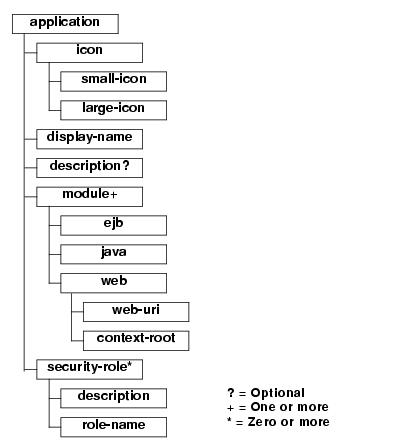application.xml Deployment Descriptor Elements
The following sections describe the application.xml file.
The application.xml file is the deployment descriptor for Enterprise Application Archives. The file is located in the META-INF subdirectory of the application archive. It must begin with the following DOCTYPE declaration:
<!DOCTYPE application PUBLIC "-//Sun Microsystems,
Inc.//DTD J2EE Application 1.2//EN"
"http://java.sun.com/j2ee/dtds/application_1_2.dtd">
The following diagram summarizes the structure of the application.xml deployment descriptor.
The following sections describe each of the elements that can appear in the file.
application is the root element of the application deployment descriptor. The elements within the application element are described in the following sections.
The icon element specifies the locations of small and large images that represent the application in a GUI tool. This element is not currently used by WebLogic Server.
Optional. Specifies the location for a small (16x16 pixel) .gif or .jpg image used to represent the application in a GUI tool. Currently, this is not used by WebLogic Server.
Optional. Specifies the location for a large (32x32 pixel) .gif or .jpg image used to represent the application in a GUI tool. Currently, this element is not used by WebLogic Server.
Optional. The display-name element specifies the application display name, a short name that is intended to be displayed by GUI tools.
The optional description element provides descriptive text about the application.
The application.xml deployment descriptor contains one module element for each module in the Enterprise Archive file. Each module element contains an ejb, java, or web element that indicates the module type and location of the module within the application. An optional alt-dd element specifies an optional URI to the post-assembly version of the deployment descriptor.
Defines an EJB module in the application file. Contains the path to an EJB JAR file in the application.
Example:
<ejb>petStore_EJB.jar</ejb>
Defines a client application module in the application file.
Example:
<java>client_app.jar</java>
Defines a Web application module in the application file. The web element contains a web-uri element and a context-root element.
- web-uri
Defines the location of a Web module in the application file. This is the name of the .war file.
- context-root
Required. Specifies a context root for the Web application.
Example:
<web>
<web-uri>petStore.war</web-uri>
<context-root>estore</context-root>
</web>
The security-role element contains the definition of a security role which is global to the application. Each security-role element contains an optional description element, and a role-name element.
Optional. Text description of the security role.
Required. Defines the name of a security role or principal that is used for authorization within the application. Roles are mapped to WebLogic Server users or groups in the application.xml deployment descriptor.
Example:
<security-role>
<description>the gold customer role</description>
<role-name>gold_customer</role-name>
</security-role>
<security-role>
<description>the customer role</description>
<role-name>customer</role-name>
</security-role>
